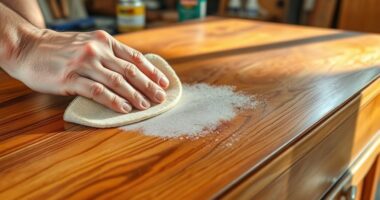To care for veneered furniture, regularly dust with a soft cloth and use gentle wood cleaners, avoiding harsh chemicals. Protect the surface from moisture, heat, and sunlight by using coasters and mats, and lift furniture instead of dragging it. Periodically apply furniture wax or polish for added protection. Fix minor scratches with touch-up kits and re-adhere loose veneer carefully. Proper maintenance preserves its beauty, and if you follow these tips, you’ll keep your furniture in excellent condition for years.
Key Takeaways
- Use a soft, lint-free cloth and gentle cleaners to regularly dust and clean the surface.
- Protect veneer from moisture, heat, and sunlight with coasters, placemats, and proper placement.
- Re-glue or re-adhere lifted or chipped veneer promptly with appropriate adhesive.
- Apply furniture wax or polish periodically to maintain shine and create a protective layer.
- Avoid harsh chemicals and abrasive scrubbers to prevent surface damage and maintain the veneer’s integrity.

Veneered furniture adds elegance and style to any space, but it requires proper maintenance to preserve its appearance. Regular cleaning routines are essential to keep the veneer looking its best and prevent dust, dirt, and grime from accumulating. Use a soft, lint-free cloth, slightly dampened with water or a gentle wood cleaner, to wipe down surfaces regularly. Avoid harsh chemicals or abrasive scrubbers, as they can damage the veneer’s delicate surface. For stubborn spots or sticky residues, a mild soap solution can be effective, but always test it on a small, hidden area first to ensure it doesn’t cause discoloration or damage. After cleaning, dry the surface thoroughly with a clean cloth to prevent water spots or warping. Proper ventilation in the room can also help prevent moisture buildup that could harm the veneer over time.
When it comes to repair techniques, understanding how to address minor damages can extend the lifespan of your veneered furniture. Small scratches or chips are common and can often be fixed with touch-up kits that match the veneer color. For deeper scratches or areas where the veneer has lifted or chipped away, you might need to carefully re-glue or re-adhere the veneer using a suitable adhesive. Applying a thin layer of glue to the underside of the loose veneer, then pressing it firmly back in place, usually does the trick. Clamp the piece gently and wipe away any excess glue before it dries. If the veneer is severely damaged or missing, replacing the affected section might be necessary, and this is best handled by a professional to ensure a seamless finish.
Preventative repair techniques also include protecting the furniture from excessive moisture, heat, and direct sunlight, which can cause the veneer to warp, crack, or fade over time. Use coasters, placemats, and avoid placing hot or wet items directly on the surface. When moving your furniture, lift it rather than dragging it to prevent stress on the veneer joints. Applying furniture wax or polish periodically can help maintain the veneer’s shine and provide a protective barrier against minor scratches. Just be sure to choose products specifically designed for veneered surfaces and follow the manufacturer’s instructions carefully. Additionally, proper maintenance practices can help ensure your veneered furniture remains beautiful and durable for years to come.
Frequently Asked Questions
How Can I Identify Genuine Veneered Furniture From Fake?
To identify genuine veneered furniture, start by examining the wood grain; real veneer often has consistent, natural patterns, while fake ones may look too uniform. Use a magnifying glass to check veneer thickness testing—genuine veneer is thin and reveals layers beneath. Gentle tapping can also help; authentic veneer produces a hollow sound, unlike thick, solid wood. These methods help you distinguish real from fake veneer confidently.
What Are Common Mistakes to Avoid During Cleaning?
You should avoid overusing abrasive cleaners, as they can scratch and damage your veneered furniture’s delicate surface. Neglecting regular dusting is another common mistake, leading to dirt buildup that dulls the finish. Instead, use a soft cloth and gentle cleaners designed for veneer. Regular dusting keeps your furniture looking its best, while careful cleaning prevents costly damage. Don’t rush—gentle, consistent care preserves its beauty for years.
Can I Use Commercial Polishes on Veneered Surfaces?
You can use commercial polish on veneered surfaces, but choose products specifically designed for veneer. Avoid harsh chemicals that might damage the delicate surface. When applying commercial polish, follow the instructions carefully to guarantee proper surface shine enhancement without causing build-up or residue. Always test on a small, inconspicuous area first to see how your veneer reacts. Regular, gentle polishing keeps your furniture looking vibrant and well-maintained.
How Often Should I Reapply Protective Coatings?
You should reapply protective coatings every 1 to 2 years to maintain their effectiveness. The reapplication frequency depends on how often you use and clean your furniture, as well as the exposure to sunlight and humidity. Regularly inspecting the protective coating helps you gauge its longevity. Reapplying when you notice signs of wear guarantees your veneer stays protected, preserving its appearance and extending the coating’s longevity.
Is It Safe to Use Water-Based Cleaners on Veneered Furniture?
Think of water-based cleaners as gentle rain for your furniture; they’re generally safe when used properly. You should feel confident using them on veneered furniture, as they’re known for being less harsh and more eco-friendly. Just make certain you use a damp cloth—not soaking wet— to avoid damage. Always check furniture safety guidelines and test a small area first to prevent any unwanted effects.
Conclusion
By following these maintenance tips, you’ll keep your veneered furniture looking stunning for years. It’s funny how a simple dusting or avoiding harsh cleaners can make such a difference, almost like fate is on your side. When you care for your furniture regularly, you’ll notice it retains its beauty longer—almost as if it’s grateful. So, stick to these practices, and your furniture will happily stand the test of time, proving that good habits really do matter.









